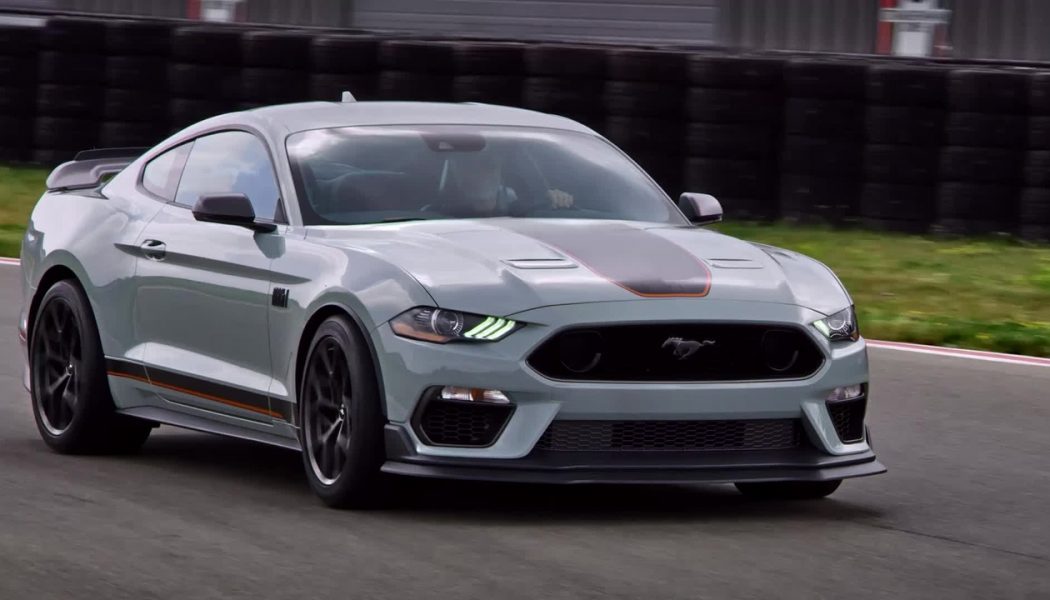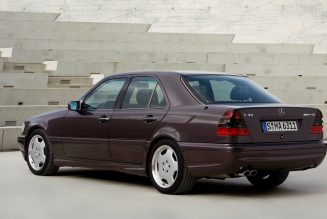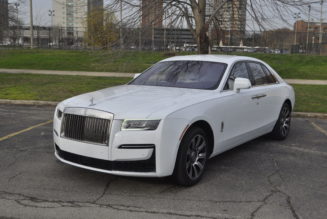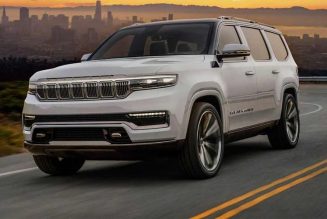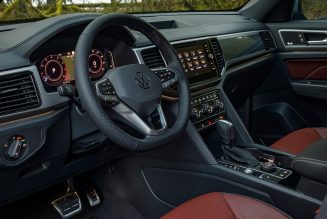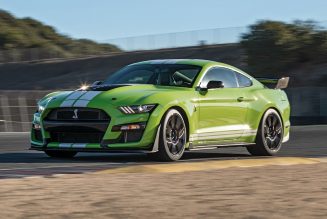Rest in thunder, 2016 to 2020 Shelby GT350. Your ethereal 5.2-liter Voodoo V-8 was too good for this low-redline world; not even the recently introduced, supercar-baiting GT500’s 7,500-rpm cutoff can match your 8,250-rpm supernova scream. Your loss is so profoundly felt, we’ve been casting about for some car—any car—to fill the hole in our heart. But that car won’t be the new 2021 Ford Mustang Mach 1. Not because it’s not great, but because it’s not supposed to be.
Conceptually, Ford asks you to consider the Mach 1 as an heir to the 2012 to 2013 Boss 302, as they’re both hopped-up, handling-focused evolutions of the contemporary Mustang GT. We partially agree, but that’s because the old, hardcore Boss is best lined up with a specific version of the new Mach 1, that being one fitted with the optional handling package.
As a whole, the new Mach 1 is a GT burger with a slice of GT350, a few strips of Boss, and a schmear of GT500 for good measure. It’s a parts-bin special in the best way, as Ford stitched together some of the most incendiary bits from the extant Mustang lineup to position the Mach 1 at the top of the 5.0-liter hierarchy.
The Mach 1 Is a Little of This, a Little of That
The Mach 1 starts with a Mustang GT outfitted with the Performance Pack 1 (PP1), meaning even the most basic iteration has that bundle’s uprated six-piston Brembo brake calipers in the front, a stiffer front suspension, a K-brace, a heavy-duty radiator, a Torsen limited-slip rear diff with 3.73 gears, and a larger rear sway bar. Every Mach 1 then stirs in specific tuning for the chassis, traction and stability control, steering, and driving modes.
The Mach 1’s 5.0-liter thrashing Coyote heart is the same one from the discontinued Bullitt, providing a healthy 480 hp and 420 lb-ft of torque, a boost of 20 horses over the GT thanks to a larger 85mm throttle body, the GT350’s intake manifold, and an open airbox. That’s delicious enough, but the coolest drivetrain upgrade is the Tremec TR-3160 six-speed manual pulled from the GT350, replacing the crunchy and problem-prone MT82 manual out of the GT and Bullitt. The GT’s standard 10-speed automatic transmission is also available, if you’re into that kind of thing.
The pickin’-n-pullin’ continues with a rear subframe shared with both the GT350 and the GT500, supporting GT500 toe links and stiffer, tighter bushings. The differential cooler is all GT500, as is the rear diffuser. MagneRide magnetorheological active dampers are standard. Checking the box next to that aforementioned $3,500 Handling package adds staggered-width 10.5×19-inch front and 11×19-inch rear lightweight wheels with a lattice pattern; those are wrapped in Michelin Pilot Sport Cup 2 tires. Also bundled in are adjustable upper strut mounts, a swing rear spoiler with the GT500’s Gurney flap, special chassis tuning, and a deeper front splitter.
Mustangs Past and Present
This wouldn’t be a true special edition Mustang without the requisite visual flair inside and out. Each Mach 1 fills rearview mirrors with lower front vents from the GT350; the left one is ducting for the engine oil cooler, the right serves cool air to the transmission. Darkened Mach 1 badges are shotgunned around the exterior, most notably on the front fender and the center of the trunklid; they’re complemented by a black hood stripe. The standard rollers are a set of retrotastic five-spoke wheels wrapped with Michelin Pilot Sport 4S tires. Inside, the Mach 1-specific trim, digital splash screens and dash plaque are predictable additions. Our favorite interior accoutrement? The white cue-ball shift knob from the Bullitt.
So, yes, it’s a big, meaty goulash of Mustangs we’ve loved before. Our introduction to how it all came together occurred at the friendly Streets of Willow racetrack via a small fleet of Mach 1s kitted out with the Handling package. According to engineers and brand reps, these ‘Stangs were bone stock aside from track alignment, including the same brake rotors, pads, and fluid buyers will have when they roll out of the dealer.
Track Time
In our experience, it can take additional time to get track-comfortable in a Mustang versus most other largish performance coupes; there’s often a pervading sensation of sitting on top of the car rather than inside it. The controls are chunky, light, and somewhat ungainly if you’re immediately transitioning from something smaller and/or lighter.
In the Mach 1, we were comfortable halfway through the first lap. As usual, Michelin’s inimitable Cup 2s continue to be street-legal cheat codes for track work; teamed with the magnetorheological suspension, the sticky shoes lowered the learning curve, and quick. The Mach 1’s power delivery is linear and caramel-thick, and it corners with no surprises whatsoever, even when treating the throttle as you might in a rental slicing through the Rockies.
Confidence, confidence, confidence. Like all Mustangs of this generation, the steering is light and lacking in ultimate feel, but the Mach 1’s setup is accurate and spectacularly predictable. Any oversteer is telegraphed early and could be caught with buttered palms, and the assist systems, well, assist with a light touch. If you stick a boot too far up the Mach 1’s rear and need to haul everything back down to sanity, the Brembos bite strong and fade late, but we were only able to pace the cars through two hot laps before a cool-down, so your mileage may vary during extended track days.
Front-end grip is tremendous, leading to bulk-defying turn-in speeds and late braking. Again, predictability is the predominant sensation, with impeccable combination footwork from the tires, suspension, and Shelby-grade rear assembly.
Transmission Triumph
The Tremec six-speed is the real star of the Mach 1’s track day show; compared to the GT and Bullitt’s MT82, the Tremec is smooth and easier to shift quickly. Unlike the GT350’s version of the 3160, though, the Mach 1’s ‘box incorporates the GT and Bullitt’s rev-match and no-lift-shift functions.
The 10-speed automatic is—of course—a less engaging experience, but special tuning to the Track mode adjusts shift points to a finer degree, and the automatic’s gear changes are quick and smooth enough to neither distract nor detract from the task at hand.
Desert Highways Made Easy
In direct contrast to the track-adjusted Mach 1s, all cars allotted for on-road evaluation left both the Handling package and the third pedal on the factory shelf. We nabbed one in a searing shade of Grabber Yellow, quickly pointing the V-8-powered highlighter down the nearest stretch of arrow-straight desert highway.
As we know from the Bullitt, MagneRide-equipped Mustangs make for excellent stealth grand tourers, provided yours is painted a less conspicuous color. Removed from the rubber-stained tarmac of Willow Springs, the Mach 1 doesn’t feel all that different from a regular Mustang GT with the PP1, especially if your preferred sources of vehicular entertainment are entry-ramp blasts and long pulls down deserted highways. The 5.0-liter’s heavy-cream roar is as savory as ever, evocatively rolling over the sandy scrubland like a fat, heavy rain cloud.
Like an AMG on the autobahn or a convertible on the coast, a Mustang in the desert is just fantastic. Resting birds shoot into the sky within a quarter mile of your approach; chest-thumping vibrations cause brake lights to come on early when you pull to the left to pass. The acceleration is wonderfully linear and perfectly suited to this sort of environment.
Where’s My Handling Package?
A white-knuckled moment in the first serious corner we encountered showed the Handling pack to be a welcome addition. There’s substantially less grip from the Pilot Sport 4S tires, there’s more body movement, and turn-in is less predictable; still, adjust your expectations, and the Shelby-like fundamentals are still there.
After some acclimation, we confidently bobbed and weaved through the undulating forests that surround the Lake Hughes and Elizabeth Lake areas, whipping local dogs into barking frenzies and shattering the peace of local campsites. On more mundane roads, the Mach 1 settled into the same low-fuss, low-muss, long-legged stride as any other modern V-8 Mustang.
At $52,915, the Mach 1 isn’t cheap, but seeing as this number cuts the difference between a GT PP1 and the aforementioned Shelby, the pricing seems right on the money. Still, it adds up—this is some $15,600 more than a base GT, $9,305 more than that same GT with PP1, and around $5,000 more than a Bullitt. Add the Handling package, and you’re looking at a $56,416 Mach 1 with the six-speed manual.
In the end, if you’re after a corner-hungry Mustang and don’t want to spring for the GT500 or a used GT350, this is your car; if you’re not that into track days or canyon carving, consider sticking with a GT PP1—with either transmission—and put the 15 or so grand you’ll save toward tires, gas, retro graphics, and hotels in the high desert. You’ll have fun. It’ll just be a little bit less than Mach 1 owners will be having.
